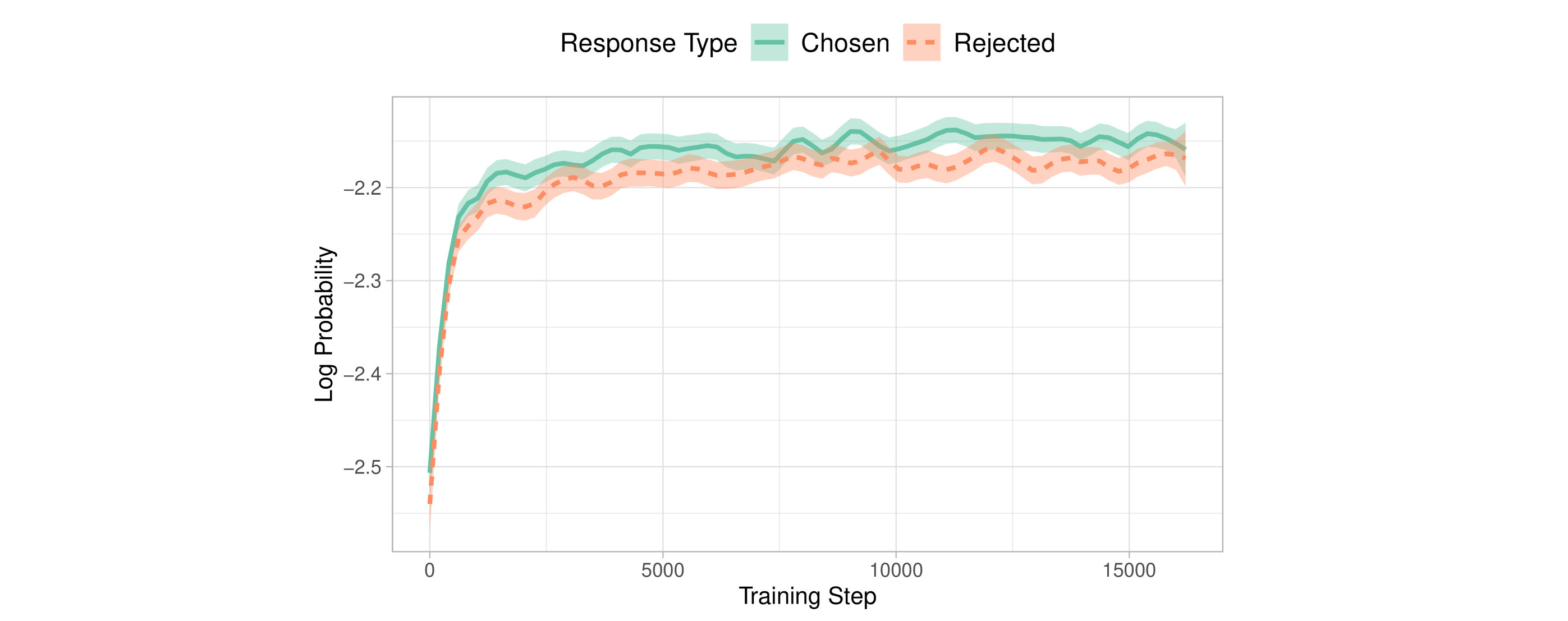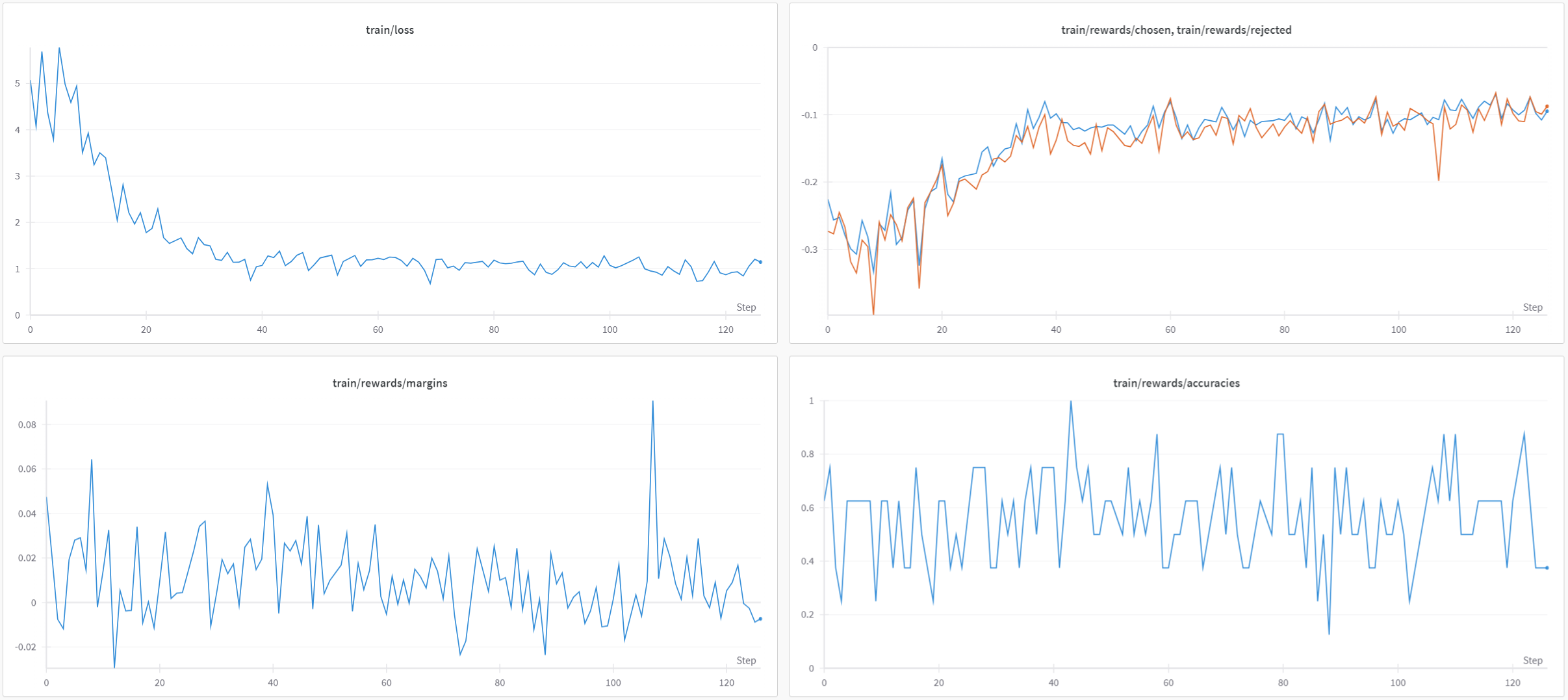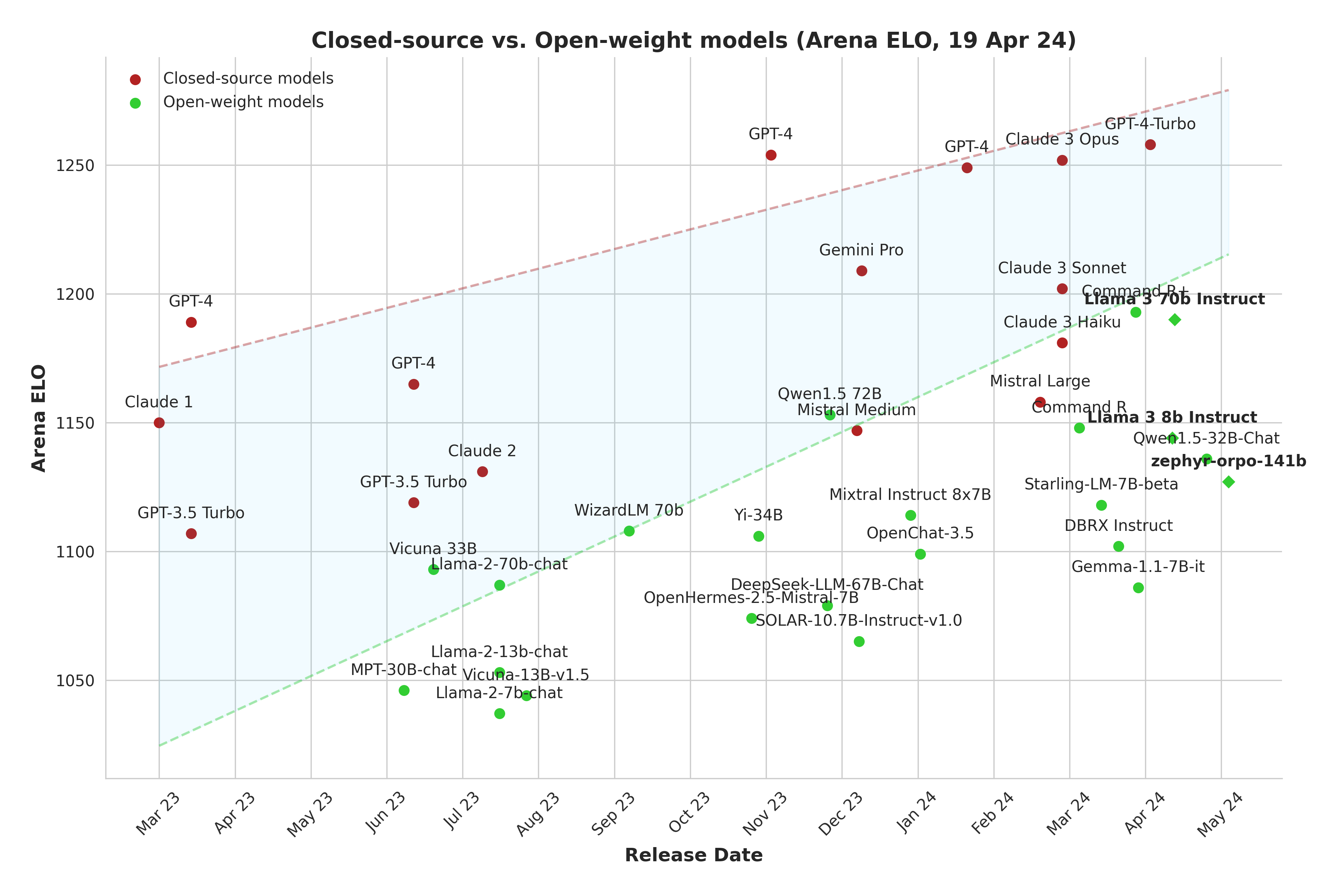 1f45bd1e8577af66a05f5e3fadb0b29
1f45bd1e8577af66a05f5e3fadb0b29
通过ORPO对llama进行微调
前言
ORPO是一种新颖的微调技术,它将传统的监督微调和偏好对齐阶段整合到一个过程中。这减少了训练所需的计算资源和时间。此外,经验结果表明,ORPO在各种模型大小和基准测试中都超过了其他对齐方法。 在本文中,我们将使用ORPO和TRL库来微调新的Llama 3 8B模型。代码可以在Google Colab(https://colab.research.google.com/drive/1eHNWg9gnaXErdAa8_mcvjMupbSS6rDvi?usp=sharing)和GitHub上的LLM(https://github.com/mlabonne/llm-course)课程中找到。
⚖️ ORPO
指令调整和偏好对齐是将大型语言模型(LLMs)适应特定任务的关键技术。传统上,这涉及到一个多阶段的过程:
- 对指令进行监督式微调(SFT)以使模型适应目标领域
- 像人类反馈的强化学习(RLHF)或直接优选优化(DPO)这样的偏好对齐方法,以增加生成优选响应而非被拒绝响应的可能性。
 微信图片_20240423001958
微信图片_20240423001958
然而,研究人员发现这种方法的一个局限性。就是监督微调(SFT)可以有效地让模型适应特定领域,这也就是为什么需要偏好对齐阶段RLHF,扩大受欢迎输出和不受欢迎输出之间概率的差距。
 image
image
SFT过程中,不受欢迎概率增加实证 from ORPO论文
2024年Hong和Lee提出的ORPO通过将SFT和RLHF统一为一个完整训练过程,为这个问题提供了一个优雅的解决方案。ORPO修改了标准language model的训练目标,将负对数似然损失与odds ratio(OR)项结合起来。这种OR损失对不受欢迎的输出施加了轻微的惩罚,同时加大奖励受欢迎的输出,允许模型同时学习目标任务并与人类偏好对齐。
 91e1091deacae95fb17f1b6995b94c2
91e1091deacae95fb17f1b6995b94c2
ORPO已经在主要的微调库中得到实现,比如TRL、Axolotl和LLaMA-Factory。在下一节中,我们将看到如何使用TRL进行操作。
💻 开始通过ORPO进行微调
Llama3是Meta开发的最新一代大型语言模型(LLM)。这些模型是在15万亿token的广泛数据集上训练的(相比之下,Llama2的训练数据集为2万亿token)。发布了两种模型尺寸:一个700亿参数的模型和一个更小的80亿参数的模型。700亿参数的模型已经展示了令人印象深刻的性能,在MMLU基准测试中得分为82,在HumanEval基准测试中得分为81.7。
Llama3模型还增加了上下文长度,最多可达8192个token(Llama2为4096个token),并且可能通过RoPE扩展到32k。此外,这些模型使用了一个带有128K-token词汇表的新分词器,减少了编码文本所需token数量的15%。这个词汇表也解释了从70亿到80亿参数的增长。
 image
image
ORPO需要一个偏好数据集,包括一个提示、一个被选择的答案和一个被拒绝的答案。在这个例子中,我们将使用mlabonne/orpo-dpo- mix-40k,这是一个由以下高质量DPO数据集组合而成的数据集:
argilla/distilabel-capybara-dpo-7k-binarized: 高分选择的答案 >=5(2,882个样本) https://huggingface.co/datasets/argilla/distilabel-capybara-dpo-7k-binarizedargilla/distilabel-intel-orca-dpo-pairs: 高分选择的答案 >=9,不在GSM8K中(2,299个样本) https://huggingface.co/datasets/argilla/distilabel-intel-orca-dpo-pairsargilla/ultrafeedback-binarized-preferences-cleaned: 高分选择的答案 >=5(22,799个样本) https://huggingface.co/datasets/argilla/ultrafeedback-binarized-preferences-cleanedargilla/distilabel-math-preference-dpo: 高分选择的答案 >=9(2,181个样本) https://huggingface.co/datasets/argilla/distilabel-math-preference-dpounalignment/toxic-dpo-v0.2(541个样本) https://huggingface.co/datasets/unalignment/toxic-dpo-v0.2M4-ai/prm_dpo_pairs_cleaned(7,958个样本) https://huggingface.co/datasets/M4-ai/prm_dpo_pairs_cleanedjondurbin/truthy-dpo-v0.1(1,016个样本) https://huggingface.co/datasets/jondurbin/truthy-dpo-v0.1 感谢argilla、unalignment、M4-ai和jondurbin提供了源数据集。
开始安装所需的库:
pip install -U transformers datasets accelerate peft trl bitsandbytes wandb
一旦安装完成,我们可以导入必要的库,并登录到W&B(可选):
import gc
import os
import torch
import wandb
from datasets import load_dataset
from google.colab import userdata
from peft import LoraConfig, PeftModel, prepare_model_for_kbit_training
from transformers import (
AutoModelForCausalLM,
AutoTokenizer,
BitsAndBytesConfig,
TrainingArguments,
pipeline,
)
from trl import ORPOConfig, ORPOTrainer, setup_chat_format
wb_token = userdata.get('wandb')
wandb.login(key=wb_token)
如果你有一块较新的GPU,你还应该能够使用Flash Attention库来替换默认的热切关注实现,以一个更有效的方式来实现。
if torch.cuda.get_device_capability()[0] >= 8:
!pip install -qqq flash-attn
attn_implementation = "flash_attention_2"
torch_dtype = torch.bfloat16
else:
attn_implementation = "eager"
torch_dtype = torch.float16
接下来,我们将使用bitsandbytes以4位精度加载Llama 3 8B模型。然后,我们使用PEFT为QLoRA设置LoRA配置。我还使用了方便的setup_chat_format()函数来修改模型和为ChatML支持的分词器。它会自动应用这个聊天模板,添加特殊的令牌,并调整模型的嵌入层的大小以匹配新的词汇表大小。 请注意,你需要提交请求才能访问meta-llama/Meta-Llama-3-8B,并且要登录到你的Hugging Face账户。或者,你可以加载未封闭的模型副本,如NousResearch/Meta--Llama-3-8B。
# Model
base_model = "meta-llama/Meta-Llama-3-8B"
new_model = "OrpoLlama-3-8B"
# QLoRA config
bnb_config = BitsAndBytesConfig(
load_in_4bit=True,
bnb_4bit_quant_type="nf4",
bnb_4bit_compute_dtype=torch_dtype,
bnb_4bit_use_double_quant=True,
)
# LoRA config
peft_config = LoraConfig(
r=16,
lora_alpha=32,
lora_dropout=0.05,
bias="none",
task_type="CAUSAL_LM",
target_modules=['up_proj', 'down_proj', 'gate_proj', 'k_proj', 'q_proj', 'v_proj', 'o_proj']
)
# Load tokenizer
tokenizer = AutoTokenizer.from_pretrained(base_model)
# Load model
model = AutoModelForCausalLM.from_pretrained(
base_model,
quantization_config=bnb_config,
device_map="auto",
attn_implementation=attn_implementation
)
model, tokenizer = setup_chat_format(model, tokenizer)
model = prepare_model_for_kbit_training(model)
现在模型已经准备好进行训练,我们可以处理数据集。我们加载mlabonne/orpo-dpo-mix-40k,并使用apply_chat_template()函数将“chosen”和“rejected”列转换为ChatML格式。请注意,我只使用了1,000个样本,而不是整个数据集,因为运行起来会花费太长时间。
dataset_name = "mlabonne/orpo-dpo-mix-40k"
dataset = load_dataset(dataset_name, split="all")
dataset = dataset.shuffle(seed=42).select(range(10))
def format_chat_template(row):
row["chosen"] = tokenizer.apply_chat_template(row["chosen"], tokenize=False)
row["rejected"] = tokenizer.apply_chat_template(row["rejected"], tokenize=False)
return row
dataset = dataset.map(
format_chat_template,
num_proc= os.cpu_count(),
)
dataset = dataset.train_test_split(test_size=0.01)
首先,我们需要设置一些超参数: 学习率:与传统的SFT或者DPO相比,ORPO使用的学习率非常低。这个值8e-6来自原始论文,大致对应于SFT的学习率1e-5和DPO的学习率5e-6。我建议在真正的微调中将其增加到大约1e-6。 beta:它是论文中的参数,其默认值为0.1。来自原始论文的一个附录显示了如何通过消融研究选择它。 其他参数,如最大长度和批量大小,都设置为尽可能多地使用VRAM(在此配置中约为20 GB)。理想情况下,我们将对模型进行3-5个周期的训练,但这里我们将坚持1个周期。 最后,我们可以使用ORPOTrainer来训练模型,它充当一个包装器。
orpo_args = ORPOConfig(
learning_rate=8e-6,
beta=0.1,
lr_scheduler_type="linear",
max_length=1024,
max_prompt_length=512,
per_device_train_batch_size=2,
per_device_eval_batch_size=2,
gradient_accumulation_steps=4,
optim="paged_adamw_8bit",
num_train_epochs=1,
evaluation_strategy="steps",
eval_steps=0.2,
logging_steps=1,
warmup_steps=10,
report_to="wandb",
output_dir="./results/",
)
trainer = ORPOTrainer(
model=model,
args=orpo_args,
train_dataset=dataset["train"],
eval_dataset=dataset["test"],
peft_config=peft_config,
tokenizer=tokenizer,
)
trainer.train()
trainer.save_model(new_model)
在L4 GPU上对这1000个样本进行模型训练大约需要2个小时。让我们查看W&B的图:
 image
image
当loss降低时,受欢迎输出和不受欢迎输出之间的差异并不明显:平均边界和准确度分别仅略高于0和0.5。
在原始论文中,作者们在 Anthropic/hh-rlhf 数据集(161k个样本)上训练模型进行了10个epochs,这比我们现在运行的时间要长得多。他们还对Llama3进行了实验,并且友好地与我分享了他们的日志(感谢Jiwoo Hong)。
在本教程的结尾,让我们将QLoRA适配器与基础模型合并,并将其推送到Hugging Face Hub。
# Flush memory
del trainer, model
gc.collect()
torch.cuda.empty_cache()
# Reload tokenizer and model
tokenizer = AutoTokenizer.from_pretrained(base_model)
model = AutoModelForCausalLM.from_pretrained(
base_model,
low_cpu_mem_usage=True,
return_dict=True,
torch_dtype=torch.float16,
device_map="auto",
)
model, tokenizer = setup_chat_format(model, tokenizer)
# Merge adapter with base model
model = PeftModel.from_pretrained(model, new_model)
model = model.merge_and_unload()
model.push_to_hub(new_model, use_temp_dir=False)
tokenizer.push_to_hub(new_model, use_temp_dir=False)
恭喜,我们完成了Llama3:mlabonne/OrpoLlama-3-8B的快速微调。你可以使用这个Hugging Face Space(这里有一个notebook,让你自己来实践)来使用它。尽管模型训练不足,正如W&B曲线所强调的那样,我还是使用LLM AutoEval在Nous的基准测试套件上进行了一些评估。
 image
image
我们的ORPO微调实际上相当不错,并且提高了基础模型在每个基准测试上的性能。这是令人鼓舞的,并且很可能意味着在整个40k样本上进行微调将带来很好的结果。
对于开源社区来说,这是一个激动人心的时刻,越来越多的高质量开放权重模型被发布。闭源和开放权重模型之间的差距正在逐渐缩小,而微调是获取您用例最佳性能的重要工具。
 image
image
结论
在这篇教程中,我们介绍了ORPO算法,并解释了它如何将SFT(监督式微调)和RLHF统一为单一的过程。然后,我们使用TRL(Transformer Reinforcement Learning)对一个定制的偏好数据集上的Llama3-8B进行微调。最终模型展示了令人鼓舞的结果,并突显了ORPO作为新的微调范式的潜力。
我希望这很有帮助,并推荐你运行Colab笔记本来微调你自己的Llama3模型。在将来的文章中,我们将看到如何创建高质量的数据集——这是一个经常被忽视的点。
最后文章参考自:https://huggingface.co/blog/mlabonne/orpo-llama-3
